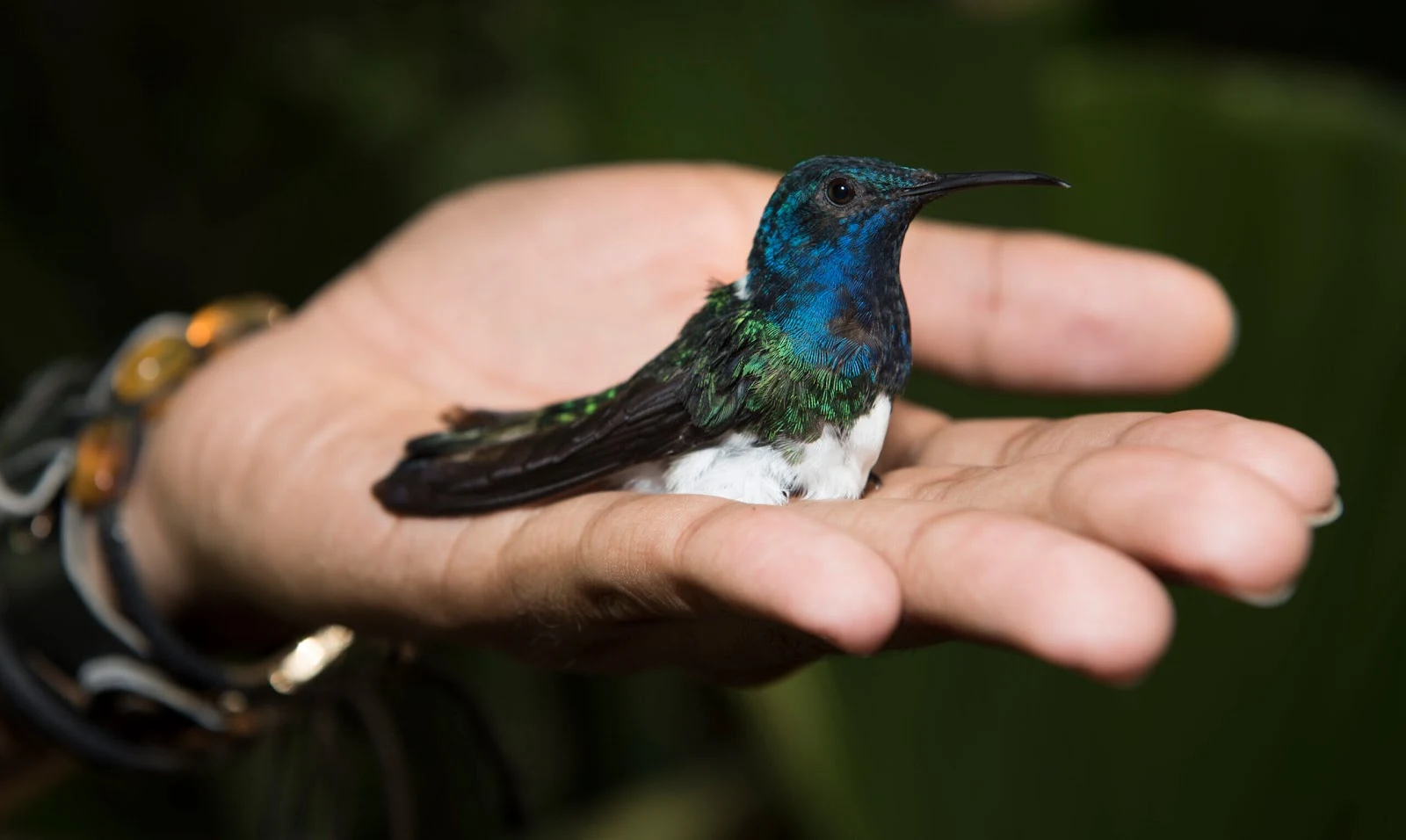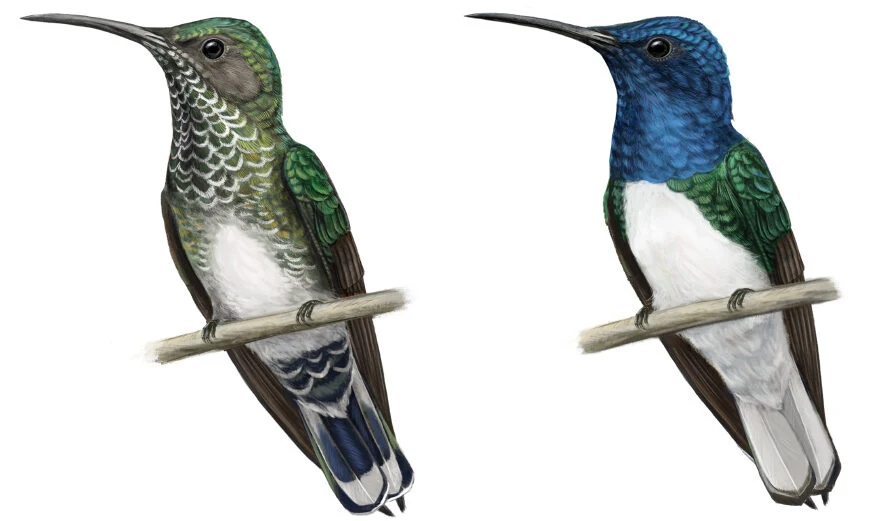A case in point, but one with a slight twist, is the fact that one in five females of the white-necked jacobin hummingbird, Florisuga mellivora, have bright 'male' plumage instead of the usual duller ‘female’ plumage, however, they still have the lighter female bodyweight and have female patterns of behaviour.
Males of the species have dazzling blue-and-white plumage, as do all juveniles. Males are also aggressive in defending their territory and food sources. About 80% of the females develop a duller, green and white plumage as they mature. This pattern, where males are brightly coloured and the females are duller is common in birds, where males display to defend their territory and to attract a mate, while the females which don’t need to display to attract a mate, can afford to be duller and more difficult for predators to see.
So ,the question is, why do about 20% of F. melliflora hummingbird develop a 'male' plumage while retaining a lighter female body and behaviour? This was the question scientists from Cornell University, Ithaca, NY, USA, Columbia University, New York, NY, USA and the University of Washington, Seattle, WA, USA set out to answer.
The answer turned out to be an unusual case of mimicry, where the females are not mimicking another species for protection, but males of the same species. This works because the males are bullies and cowards, and tend to pick on the light-weight females while avoiding picking a fight with other males and with juveniles (which also seem to be getting protection against the cowardly males by, unusually for birds, having adult ‘male’ plumage as juveniles).
As the news release from Washington University explains:
White-necked jacobin hummingbirds sport a colorful blue-and-white plumage as juveniles. When they grow into adulthood, males retain this dazzling pattern, while females develop a more “muted” palette of green and white — at least, most females. Curiously, about 20% of females defy the norm and retain male-like plumage into adulthood.The team's findings have been published, sadly behind a paywall, in Proceedings of the Royal Society B. The abstract is available here:
Now those pieces are falling into place. In research published Sept. 7 in the Proceedings of the Royal Society B, Falk and co-authors at the UW, Cornell University and Columbia University report that adult female white-necked jacobins with male-like plumage are mimicking male appearance — but not male behavior. In addition, their strength and body size are similar not to males, but to fellow females with muted plumage.Why do some female jacobins look like males? It’s a mystery made up of multiple pieces. Is there a benefit? Is there a cost? Is it just appearance, or do these females also act like males?
Females with male-like plumage don’t seem to be behaving any differently than other females. All evidence instead indicates that females that look like males are engaging in deceptive mimicry.
Even when I found average differences in female and male morphology, burst power or behavior, I also found quite a bit of overlap between the sexes. That indicates that sex isn’t the only important factor, and that variation among and between individuals plays an important role.
Dr Jay Falk, Lead author
Postdoctoral researcher Department of Biology University of Washington, Seattle, WA, USA and Department of Neurobiology and Behavio
Cornell University, Ithaca, NY, USA
The study shows that the 1 in 5 adult females with male-like plumage are engaging in “deceptive mimicry”: They are essentially trying to pass themselves off as males, without acting like them. In the process they receive quite a benefit. As Falk and his colleagues reported in a paper published last year in Current Biology, females with male-like plumage suffer less aggression from males compared to females with the more typical muted plumage, and can hang out longer at feeders.
Falk began this research as a graduate student at Cornell University and continued it as a postdoctoral fellow with co-author Alejandro Rico-Guevara, a UW assistant professor of biology and curator of ornithology at the UW’s Burke Museum of Natural History & Culture.
White-necked jacobins are common in tropical lowlands of the Americas. Males of this species, put simply, are bullies. They defend territories, chase rivals away from food sources, court females and fight. That aggressive behavior relies on an underlying difference in body size and physiology: Male jacobins are larger and are better at combative flight compared to dull-colored females.
Illustrations of the muted plumage typical of most adult female white-necked jacobin hummingbirds, shown on the left, and the blue-and-white plumage of all males and approximately 20% of adult females, on the right.
Jillian Ditner
An unanswered question from Falk’s previous study was whether females with male-plumage also displayed male-like flight power or behavior. At a field site in Panama, he briefly captured male jacobins and females with both types of plumage. He discovered that females — regardless of plumage — had essentially identical body and wing sizes, whereas males were slightly larger. Before releasing the birds, Falk also tested their “burst power” — or muscle capacity during flight — by seeing how high they could fly while lifting a chain of small, weighted beads. Females of both types of plumage had identical burst power, while males could lift more on average.
Using data from radio-tagged birds in the wild, the team also discovered that more males fed in a “territorial” pattern — spending longer amounts of time at a smaller number of feeding sites. All females, regardless of plumage, showed the opposite pattern: feeding for shorter periods of time at sites across a larger territory.
Many examples of deceptive mimicry occur between species: a harmless species will mimic the coloration of a noxious species as an anti-predator defense. In the Americas, for example, some non-venomous kingsnake species have evolved colorful banding patterns that resemble venomous species in the same area, such as coral snakes. Research showed that this deceptive mimicry decreased predation of the kingsnakes, which are not venomous. What Falk and his colleagues found in white-necked jacobins appears to be an example of deceptive mimicry within a species.
Scientists have reported females with male-like plumage in other hummingbird species. If so, male mimicry within hummingbird species may be more common than currently known. Next year, Falk will move to the University of Colorado Boulder to study the genetic differences between females with muted and male-like plumage — and potentially identify how this deception evolved.
AbstractSo then, let’s look at this from the intelligent [sic] design superstition's perspective. Remember, by dogma, only one designer is permitted to exist, so every move and countermove is being made by the same designer, apparently in competition with itself:
Female-limited polymorphisms, where females have multiple forms but males have only one, have been described in a variety of animals, yet are difficult to explain because selection typically is expected to decrease rather than maintain diversity. In the white-necked jacobin (Florisuga mellivora), all males and approximately 20% of females express an ornamented plumage type (androchromic), while other females are non-ornamented (heterochromic). Androchrome females benefit from reduced social harassment, but it remains unclear why both morphs persist. Female morphs may represent balanced alternative behavioural strategies, but an alternative hypothesis is that androchrome females are mimicking males. Here, we test a critical prediction of these hypotheses by measuring morphological, physiological and behavioural traits that relate to resource-holding potential (RHP), or competitive ability. In all these traits, we find little difference between female types, but higher RHP in males. These results, together with previous findings in this species, indicate that androchrome females increase access to food resources through mimicry of more aggressive males. Importantly, the mimicry hypothesis provides a clear theoretical pathway for polymorphism maintenance through frequency-dependent selection. Social dominance mimicry, long suspected to operate between species, can therefore also operate within species, leading to polymorphism and perhaps similarities between sexes more generally.
Falk, Jay J.; Rubenstein, Dustin R.; Rico-Guevara, Alejandro; Webster, Michael S.
Intersexual social dominance mimicry drives female hummingbird polymorphism
Proceedings of the Royal Society B: Biological Sciences 1922 287(1982), 20220332; DOI: 10.1098/rspb.2022.0332
© 2022 The Authors
Published by The Royal Society
Reprinted under the terms of the Copyright, Designs and Patents Act 1988, s60.
Firstly, the intelligent [sic] designer designs the two sexes of F. mellivora to have different plumages; the males because they need to display and defend territory and food resources, at the expense of a greater risk of predation; the females so they are harder for a predator to see generally and especially while incubating eggs. Then it designs the behaviour of the males to be cowardly bullies who will be more likely to attack the lighter and weaker females than the stronger males. Then, having realised that attacking females the way it designed the male to behave, was a problem for the females, it redesigned some of the females so they are less likely to be attacked by the males. But it only provides 20% of the females with this solution for the problem it created for them, presumably, because this solution now created a problem for the males, who were now too cowardly to defend territory and food resources effectively. At every turn, the solution it created to solve the problem it created was now a problem to be solved.
It's exactly like the intelligent [sic] designer is behaving like a mindless natural process with no intelligence, no plan and no foresight about what its designs will do, and most importantly, no ability to scrap its designs and start again, so it just blunders blindly on, with no ultimate purpose, not knowing what it's trying to achieve.
In fact, it's exactly like the 'designer' is the process described by biologists in the scientific Theory of Evolution by Natural Selection.
But creationists would rather we thought of their putative designer god as an unthinking, incompetent fool without a plan, than accept that a mindless natural process is responsible for biodiversity.




No comments :
Post a Comment
Obscene, threatening or obnoxious messages, preaching, abuse and spam will be removed, as will anything by known Internet trolls and stalkers, by known sock-puppet accounts and anything not connected with the post,
A claim made without evidence can be dismissed without evidence. Remember: your opinion is not an established fact unless corroborated.